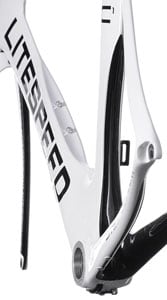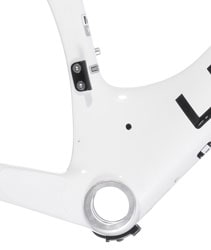Out of Stock
Don't worry though, we have a lot more Custom Road Bikes & Frames in stock than that.
Shop Similar ProductsC1
We're not quite ready for the ProTour, no matter how well we maximize the tan lines on our legs. We're logging the miles because we want to go fast, put the hurt on our friends, and drop our rivals at the races. We want our equipment to give us an edge, but we don't want to have to work a second job to afford our gear. It's for this reason that the Litespeed C1 is dear to us.
It comes out of the same mold as the ProTour-ready C1R, so it has the same shaping for ride quality and aerodynamics. It has the same fork. It's different in that it doesn't have a seat mast, which for many of us is a bit of an annoyance, and the cables are routed internally. The cost in frameset weight is 50g in a Medium compared to the C1R, and that's because the lay-up includes more 40T carbon-fiber cloth, which also takes away a tiny bit of the stiffness (aka makes the ride a bit more comfortable).  We probably could lose a little body weight, and it's not like we crank out 1600 watts in a sprint. All in all, a pretty good deal.
We probably could lose a little body weight, and it's not like we crank out 1600 watts in a sprint. All in all, a pretty good deal.
As we described the C1R, the C1 is a marvel to look at. In person, they're dizzying. The scaled images you see hide the gloriously varied shapes of the frameset. Just take a look at the down tube. It looks huge. In person, you can see how the tube subtly changes shape throughout its length. There is no extreme flare where the down tube meets the bottom bracket, but a gradual widening of the tube as it travels from the head tube. The profile at the trailing edge of the down tube widens near the cage mount, giving room for your water bottle to nestle somewhat hidden from the wind. At the back of the bike, the seat stays are wide and flat for shock absorption where they join the seat tube and they morph on their journey to the rear dropouts, becoming narrow and more aero because more wind passes over them by the dropouts. Same goes for the top tube, which starts out massive for front end stiffness and getting small for compliance by the seat tube. And when you look at a Small frame next to a Medium, next to a Large, you'll see subtle differences in the shaping as well; Litespeed takes each frame as its own design rather than just doing just one tubing design for the entire size run.
Litespeed is part of the American Bicycle Group, the same company that owns Quintana Roo. Thanks to this tie to QR, Litespeed has access to lots and lots of wind tunnel data. This helped them go into the wind tunnel with some pretty good ideas on how to make a bike frame more aerodynamic. The shaping described above they call Aerologic. And their test data shows it really works. They took their Archon Ti' and C frames to the A2 tunnel, equipped them with identical components and ran the tests at the industry-standard 30mph speed. The reduction in drag goes from a minimum of 100g of drag when the bike is facing directly into the wind to a maximum of almost 200g. The difference is about the equivalent of adding a set of aero wheels to a regular road bike; only you're getting that benefit with training wheels. It's that much faster when you put on your aero race wheels.
Part of the design advantage comes from the fork shape. It's a bit different from most integrated carbon fiber forks in that the crown is designed to help airflow around the frame, and the legs are narrow and placed a bit wider than usual to give more room for air to flow around the wheels. It's a faster shape than many forks. The crown is a great example of how integrated components should work, as it flows seamlessly into the head and down tubes.
Inside the head tube, the fork is forward-thinking as well. The steerer is carbon-fiber and tapered, with a 1-1/8" race at the top and a 1.5" at the bottom. The rake is 43mm. The fork tips are carbon-wrapped Inox stainless steel.
An important feature of Litespeed's molding process is what they call Reactive Pressure Molding, or RPM for short. In addition to using bladders, they also use internal forms that help press out from the inside to eliminate voids without leaving molding parts behind when the process is done. RPM is another way Litespeed saves weight and increases strength.
There wasn't an aspect of frame building too tiny to escape Litespeed's eye. Even the dropouts have been considered and changed. They may look like carbon,  but there are Inox stainless steel skeletal pieces inside and they've been over-molded with carbon-fiber. The replaceable derailleur hanger is stainless, too.
but there are Inox stainless steel skeletal pieces inside and they've been over-molded with carbon-fiber. The replaceable derailleur hanger is stainless, too.
Because of the massive down tube, a traditional front derailleur clamp can't fit, so it has a "braze on" hanger. The bottom bracket is a BB30 design to optimize light weight and stiffness. If you're not a fan of BB30 or would prefer to use your favorite crank and bottom bracket combo, adapters are available for an easy conversion. The cable guides are internal and are fully threaded so all you have to do is start pushing through cable and it will eventually come out the other end. Note, though you can thread the guides without cable housing, Litespeed recommends threading housing, as the cables will feel smoother when you actuate a lever or button. The C1 is also fully configured for internal routing of Di2 wires. You can have the finest shifting known to man and supreme aerodynamics all at the same time.
Litespeed offers a limited lifetime warranty on their frames that will cover manufacturing defects. They also have a crash replacement policy.
The Litespeed C1 comes in White/Black. Sizes are Small, Medium, Medium/Large, Large, and X-Large. The C1 comes with a proprietary seatpost. The saddle clamp assembly on the post is a two-bolt design from FSA with 20mm of setback. The seatpost and clamp assembly come with the frame.
Details
- Item #LTS0065
Reviews
Q&A
What do you think about this product?
View
Selecting an option will reload the available reviews on the pageSorry, we don’t currently have any of those types of reviews for this product.
Do you have a question about this product?